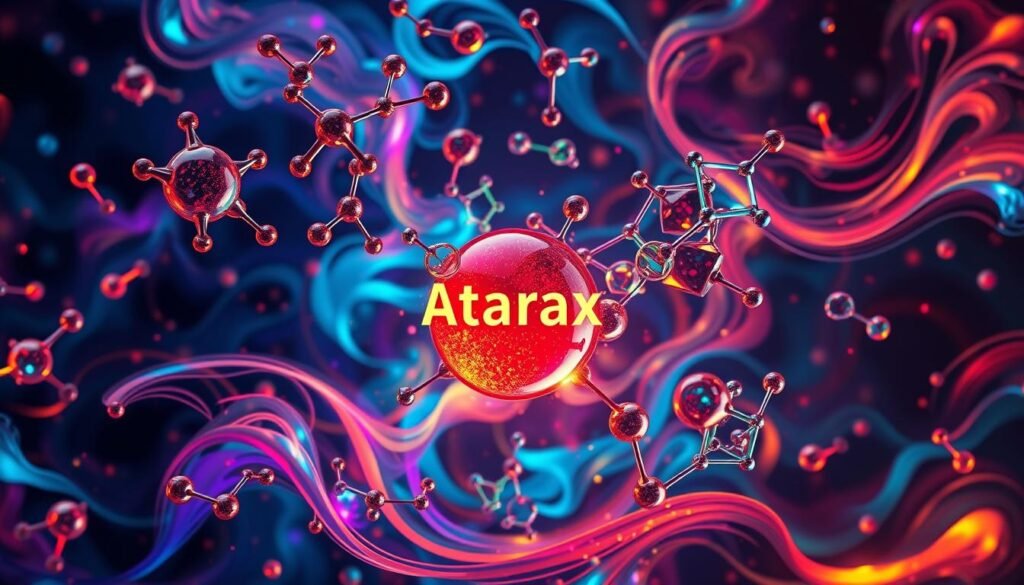Did you know about 40 million adults in the United States are dealing with anxiety disorders? This makes the search for effective treatments very important. Atarax, known scientifically as hydroxyzine, is being looked at as an alternative to common anxiety meds like benzodiazepines. In 2002, a study with 369 patients showed how safe and effective Atarax can be.
This article explores how Atarax works, its uses, how much to take, possible side effects, and what patients say about it. You’ll have all the important facts you need. For more information, check out this resource.
Key Takeaways
- Atarax is effective in managing anxiety and treating allergies.
- Dosage commonly ranges from 50 to 100 mg, taken four times daily.
- Potential side effects include drowsiness and dry mouth.
- Consultation with a healthcare provider is crucial before use.
- Atarax may not be suitable for patients over 65 years old.
- Hydroxyzine’s calming effects generally manifest within 30 to 60 minutes.
What is Atarax?
Atarax is a type of antihistamine medicine mainly used to treat anxiety and tension from psychoneurosis. It goes by the scientific name hydroxyzine hydrochloride. Besides calming anxiety, it helps stop itching from allergies and can be a sedative for surgeries.
Hydroxyzine comes in tablets, syrup, and injections. But we are focusing on the tablet form here. If you wonder what is atarax, know it’s safe and non-addictive if used right. It usually starts working in 30 to 60 minutes, making it good for quick relief from anxiety.
Hydroxyzine isn’t always the first choice for treating anxiety. Doctors might suggest other medicines like paroxetine or sertraline first. You shouldn’t use hydroxyzine for anxiety for more than four months. This helps prevent tolerance to the drug.
The right dose of hydroxyzine depends on the person’s age and what’s being treated. Adults often take 50 to 100 mg up to four times a day. Dosages for kids and older people can vary. It’s important to follow a doctor’s advice when using hydroxyzine for anxiety.
Using hydroxyzine can lead to side effects like feeling sleepy or having a dry mouth. It’s important for users to be careful, especially when doing things that need full focus. Knowing the benefits and risks of hydroxyzine is key to using it wisely for anxiety.
For more details on hydroxyzine’s use and effects, you can check out this source and this reference.
How Atarax Works for Anxiety
Understanding how Atarax works is key for anyone thinking of using it for anxiety. Atarax contains the substance hydroxyzine. It calms the central nervous system. This reduces anxiety and stress.
Research shows Atarax is quite effective for anxiety. Its effectiveness ratio is 0.30, much higher than a placebo. The studies involved 884 people, indicating it’s a solid choice for managing anxiety.
Hydroxyzine also acts as a sedative. It helps those facing acute anxiety quickly. While it’s promising, looking into its long-term effects is important for both doctors and patients.
Atarax Anxiety: Uses and Benefits
Atarax is mainly used for short-term anxiety relief. It is a trusted choice for people aiming to control their anxiety symptoms. Atarax uses go beyond just calming anxieties. It also acts as an antihistamine. This makes it effective for treating allergic reactions like hives’ itching. Atarax starts working quickly, usually in 15 to 30 minutes after taking it orally, which is great for urgent needs.
Many patients notice the benefits of atarax for anxiety. It helps lessen anxiety symptoms, improving their life quality. With reduced anxiety, they engage more in daily life, free from the unease that once held them back.
To sum up, Atarax offers a versatile solution for anxiety and allergies. It provides fast relief, improving the well-being of those with anxiety disorders. Health experts confidently recommend it for quick reduction of anxiety stress.
| Use | Description |
|---|---|
| Anxiety Relief | Short-term relief of anxiety and tension |
| Allergic Reactions | Treatment for itching associated with hives |
| Onset of Action | Effective within 15 to 30 minutes after intake |
| Quality of Life | Improves patient engagement in daily activities |
Dosage of Atarax for Anxiety Management
It’s vital to get the atarax dose right for anxiety relief. Atarax, or hydroxyzine, helps adults and children fight anxiety. The dose a person needs can change based on their situation.
Recommended Dosage for Adults
Adults often take 50 to 100 mg of atarax up to four times a day for anxiety. How much you need depends on how severe your anxiety is. Never take more than 400 mg in a day for anxiety.
Talking to a doctor to adjust the dose is key. This ensures the treatment works without risking safety.
Dosage for Children
Children under 6 should take up to 50 mg of atarax in two to four doses each day. For kids 6 and older, the dosage can be 50 to 100 mg daily, split into two to four doses. A healthcare provider must watch over the child’s treatment. They make sure the dose is both safe and right for the child’s needs.

Potential Atarax Side Effects
Atarax (hydroxyzine) can effectively treat anxiety, but it’s important to know the possible side effects. This knowledge helps make informed health decisions and ensures good care.
Mild Side Effects
The mild side effects of Atarax are:
- Dry mouth
- Drowsiness
- Fatigue
- Headache
- Difficulty concentrating
These effects usually don’t last long. If they do, tell your healthcare provider to get the right help.
Serious Side Effects
Certain serious side effects of Atarax need quick action. QT prolongation is one. It affects heart rhythm, causing severe dizziness or fainting. People with heart problems or on certain drugs should be cautious.
Also, watch out for:
- Severe allergic reactions
- Skin reactions needing quick medical help
It’s very important to be aware of these risks for safe Atarax use. Learn more about other meds by checking out Topiramate for anxiety.
Hydroxyzine as an Alternative Treatment for Anxiety
Hydroxyzine, found in Atarax, is an alternative for those who need relief from anxiety. It is very helpful for short-term use and responds fast to anxiety symptoms. This makes hydroxyzine a strong option when other medications don’t work well.
This antihistamine can deal with anxiety safely compared to benzodiazepines. It is used in doses from 25 mg to 100 mg per day. This helps to quickly calm acute anxiety symptoms. People usually feel better in 15 to 30 minutes after taking it.

Hydroxyzine stands out because it is not addictive. It’s perfect for people who only sometimes feel anxious. Health professionals often use it while waiting for other medications to take full effect.
But, talking to health care providers is crucial before using it long-term. Anxiety disorders are very common in the U.S., affecting about 32% of people at some point. Considering all treatment options, including hydroxyzine, can really help improve life quality.
| Aspect | Hydroxyzine | Benzodiazepines |
|---|---|---|
| Onset of Action | 15-30 minutes | Varies; generally longer |
| Duration of Effect | 4-6 hours | Varies; can last hours to days |
| Habit-Forming Potential | No | Yes |
| Typical Dosage | 25-100 mg/day | Varies widely |
| Use Case | Short-term relief | Long-term management |
Understanding Atarax Reviews and User Experiences
People have shared their experiences with Atarax, giving it an overall score of 3.9 from 213 reviews. Many found it helpful for managing anxiety. 94 users even gave it a perfect score for its effectiveness in calming anxieties. These atarax reviews tell of the benefits users have found.
It’s also easy to use, according to 146 people who rated it five stars. This suggests that Atarax fits nicely into daily life. And with 91 people completely satisfied, the feedback looks positive.
However, not everyone is happy. Some mention side effects like drowsiness and confusion. 31 users even rated it one star because of their experiences. This gives us a full view of what it’s like using Atarax.
For specific problems like itching, Atarax gets an even better score of 4.3. This difference highlights how it works well for various issues. By looking at a range of feedback, those interested in Atarax can get a comprehensive understanding.
Drug Interactions with Atarax
Knowing how drug interactions with atarax work is key to safe use. Atarax, or hydroxyzine, can mix poorly with some medications. This may increase sedation and other side effects. It’s crucial for patients to tell their doctors about all medicines they’re taking.
CNS Depressants
Some drugs, called CNS depressants, make Atarax’s sedative effect stronger. These drugs include:
- Opiate analgesics (e.g., oxycodone, morphine)
- Benzodiazepines (e.g., alprazolam, lorazepam)
- Muscle relaxants (e.g., cyclobenzaprine, methocarbamol)
- Anticonvulsants (e.g., gabapentin, pregabalin)
- Hypnotics (e.g., Ambien, Lunesta)
- Antidepressants (e.g., Prozac, trazodone)
When mixed with Atarax, these drugs can cause deep sleepiness. They can also make accidents or falls more likely. People should be very careful when doing activities like driving.
Other Medications to Consider
Atarax may also react with drugs that cause QT prolongation. This can seriously affect the heart. Watch out for these drugs:
| Medication Type | Examples | Potential Risk |
|---|---|---|
| Antiarrhythmics | Amiodarone, Sotalol | Increased risk of life-threatening arrhythmias |
| Antidepressants | Citalopram, Fluoxetine | QT prolongation risk |
| Antipsychotics | Quetiapine, Risperidone | Potential cardiac complications |
Talking to healthcare pros about atarax and other meds is crucial. This ensures safety and reduces risks during treatment.

Precautions and Warnings for Atarax Use
Safety is crucial when it comes to Atarax. Before using it, patients must talk to their doctors. They should share their entire medical history. It’s critical to tell the doctor about any breathing problems, glaucoma, or heart issues. These conditions can increase the risks of taking Atarax.
Older individuals and children might react more to Atarax’s effects. This can cause negative reactions. So, watching their response to the medication closely is key. Warnings about atarax stress careful use in these sensitive groups.
If you’re pregnant or breastfeeding, talk to a healthcare provider first. The effects of Atarax on these groups aren’t fully known. Using Atarax without medical advice can be risky for both the mother and the baby.
For more details on safely using Atarax, click here. Understanding these guidelines is important for everyone involved.
| Group | Precaution | Note |
|---|---|---|
| Older Adults | Increased Sensitivity | Higher risk of falls and confusion |
| Children | Heightened Sensitivity | May cause excitement instead of sedation |
| Pregnant/Nursing | Consult a Healthcare Provider | Lack of safety data for these groups |
Conclusion
Atarax stands out as a powerful choice for those needing help with anxiety. It works quickly and offers many benefits for people with anxiety disorders. Yet, it’s key to remember that Atarax can have side effects and interact with other drugs. Talking openly with healthcare providers is crucial to create a treatment plan that fits your anxiety needs.
Atarax is particularly good for short-term help with anxiety. Many studies, especially on hydroxyzine, show it’s likely to work better than a placebo. This is promising for treating Generalized Anxiety Disorder (GAD). But, patients should balance the benefits against the risks, like tolerance or drowsiness.
As a non-addictive choice, Atarax is important in the fight against anxiety. With over 30% of U.S. adults battling anxiety disorders, access to dependable treatments is essential. Fully understanding Atarax helps people make smart choices in their anxiety care plans.